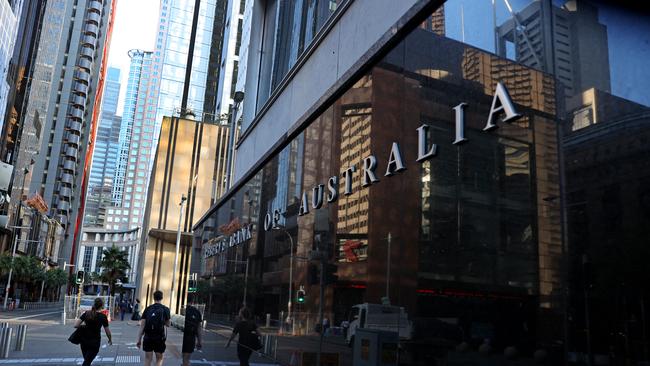RBA sets in motion rate rises to 2pc by end of the year
The RBA is unlikely to rule out 50-basis point moves in any given month, especially if the inflation outlook deteriorates further.

The Reserve Bank of Australia’s assertive raising of the cash rate by 25 basis points in the wake of the biggest inflation print in 20 years has likely set in motion what will likely be an unbroken string of rate increases stretching all the way to December.
That scenario would take the cash rate to around 2 per cent by the end of 2022, from 0.35 per cent currently, and the RBA is unlikely to rule out 50 basis-point moves in any given month, especially if the inflation outlook deteriorates further, or there is an expected jump in wage growth that exceeds forecasts.
This is an extremely plausible scenario that puts the central bank somewhere between the hawkish bets being placed by money-market traders – which tip the cash rate at more than 3 per cent by year’s end – and the outlook of many bank economists, which expect the RBA to act more timidly and take the cash rate to just 1.25 per cent.
The first-quarter consumer price index data published in late April included headline inflation running at 5.1 per cent on year, and core inflation at 3.7 per cent. The numbers have forced a total reset of thinking at the RBA as it moves to make up lost ground.
The massive reorientation of the RBA’s policy objectives is already evident in forecasts. It now projects core inflation at an eye-watering 4.75 per cent by the end of 2022, with headline inflation at 6 per cent in the same time frame.
READ MORE:The RBA is just getting started as rates start to rise | NAB, CBA, ANZ, Westpac hike mortgage rates | Aussie mortgage pain: how 1990 rate hit compares with today
The job of getting inflation back to the central bank’s 2 per cent to 3 per cent target band will be drawn out, and require the use of a big stick.
The RBA has admitted that it didn’t foresee the full extent of the price pressures that have emerged across the economy, and it will likely move with a force in the early stages of the tightening cycle that might surprise some. The second phase of tightening might be milder as the RBA takes the cash rate back to a neutral 2.5 per cent in 2023.
It will keep a close watch on the housing sector throughout, as any overeagerness could easily topple the housing market, one of the most indebted in the world.
With more than 1 million households in Australia having never experienced an interest rate rise prior to this week – the last was delivered in November 2010 – an added 2 per cent on mortgage interest rates by the end of year would be a huge burden for many.
The RBA has already published modelling indicating that a 200-basis-point rise in the official cash rate will lower house prices by 15 per cent nationally.
Some policy makers say that highly elevated household savings in Australia could make it harder for the RBA to cool the economy, forcing even more aggressive interest rate increases over time.
The many billions deployed in fiscal stimulus to soften the blow of pandemic lockdowns remain locked away in saving accounts, giving consumers an ample buffer to deal with rising mortgage interest rates. This suggests that even more interest rate increases than planned.
However, consumers may prove much less resilient in reality as the toxic mix of falling real wages, quickly rising mortgage costs, and falling house prices takes a big toll on confidence.
The good news is that while current inflation prints appear deeply concerning, the data may prove to be less threatening than feared as one-off factors such a 14 per cent rise in home building costs over the past year are unlikely to be repeated.
If the temporary factors pushing up inflation drop out of calculations, the heat will come off the RBA, and lower the so-called terminal rate for the cash rate.
There is a lot of uncertainty facing the RBA at the moment, but count on it acting with purpose and some force in the run up to Christmas as it moves to put the inflation genie, now enjoying rare freedom, back into the bottle.
DOW JONES



